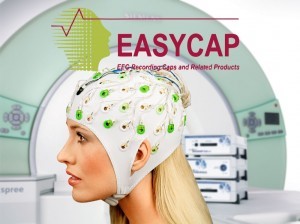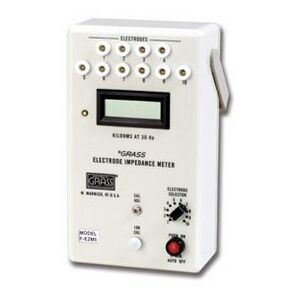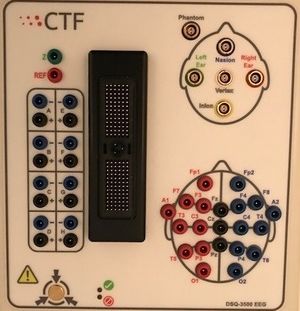Subject Preparation: EEG: Difference between revisions
mNo edit summary |
|||
| (8 intermediate revisions by the same user not shown) | |||
| Line 2: | Line 2: | ||
==EEG Reference Electrode Setup== |
==EEG Reference Electrode Setup== |
||
Reference |
Reference electrodes are used to define the common point for the electronics. |
||
*Left and Right Mastoid Placement - Bone prominence behind the ear. |
|||
Attach the reference electrodes to the left and right mastoids (the bone prominence behind each ear). |
|||
| ⚫ | |||
'''Procedure:''' |
|||
| ⚫ | |||
:1. Clean the skin behind each ear with Nuprep Skin Cleaner. Wipe the skin with an alcohol wipe to remove the gritty residue. |
|||
*Apply Elifix Electrolyte through the electrode opening. |
|||
| ⚫ | |||
| ⚫ | |||
:3. If using Ten/20 paste, carefully scoop into the electrode cup. Otherwise, press the electrodes onto the skin and apply electrolyte gel through the electrode opening with a syringe. |
|||
| ⚫ | |||
| ⚫ | |||
| ⚫ | |||
| ⚫ | |||
| ⚫ | |||
| ⚫ | |||
| ⚫ | |||
| ⚫ | |||
| ⚫ | |||
| ⚫ | |||
*Secure with tape. |
|||
::*If the impedance level is too high, abrade the skin again and reapply the electrode. |
|||
| ⚫ | |||
:6. Secure electrodes in place with Transpore (medical) tape. |
|||
<br> |
<br> |
||
| Line 82: | Line 85: | ||
==Reducing Skin Impedances== |
==Reducing Skin Impedances== |
||
[[File: NUPREP_Picture.jpg|frameless| |
[[File: NUPREP_Picture.jpg|frameless|left|200px|Nuprep]] |
||
| ⚫ | |||
[[File: Lemon_Prep_Picture_cropped.jpg|frameless|right| Lemon Prep]] |
|||
| ⚫ | |||
*Insert the wooden end of a cotton swab through the opening of the electrode to push hair aside (in one direction) until the skin is clearly visible. |
*Insert the wooden end of a cotton swab through the opening of the electrode to push hair aside (in one direction) until the skin is clearly visible. |
||
*If the hair is long, lift up the electrode a little and let it down again while moving back the swab to grab a new bunch of hair (this will prevent the hair from slipping back). |
*If the hair is long, lift up the electrode a little and let it down again while moving back the swab to grab a new bunch of hair (this will prevent the hair from slipping back). |
||
*Dip the swab into the Nuprep |
*Dip the swab into the Nuprep and insert through the electrode opening. |
||
*Twirl the swab against the skin using the thumb and index finger. |
*Twirl the swab against the skin using the thumb and index finger. |
||
| Line 94: | Line 96: | ||
==Applying Electrolyte== |
==Applying Electrolyte== |
||
[[File: Ten_20_Paste_Picture1.png.jpg|frameless|right|Ten/20 Conductive Paste]] |
[[File: Ten_20_Paste_Picture1.png.jpg|frameless|right|Ten/20 Conductive Paste]] |
||
'''Ten/20 Conductive Cream |
'''Ten/20 Conductive Cream is an opaque white, water soluble electrolyte substance used as a conductive and/or fixing/adhering medium to attach electrodes. Removed with warm water.''' |
||
| ⚫ | |||
| ⚫ | |||
::'''*If using Elifix or Abralyt''' - fill a syringe with the cream. |
|||
:'''*If using a liquid electrolyte like Electrogel, Elifix or Abralyt''' |
|||
| ⚫ | |||
::*Fill a syringe with the solution. |
|||
| ⚫ | |||
| ⚫ | |||
::::- Press firmly on the skin. |
|||
::'''*Completely fill the electrode space (the space from the skin to the electrode) with cream / paste so that there are no air pockets and the electrolyte makes good contact with the skin. |
::'''*Completely fill the electrode space (the space from the skin to the electrode) with cream / paste so that there are no air pockets and the electrolyte makes good contact with the skin. |
||
| Line 105: | Line 107: | ||
<br> |
<br> |
||
'''NOTE:''' You are not required to use Ten/20 paste, however care should be take when selecting an electrolyte solution/paste for use in MEG. Many solutions, if not prepared specifically for use in MEG, may have magnetic contaminants. |
|||
*CTF released the following advisement: [[Image:pdf.png]] [[Media:TA-031-EEG Gel Magnetic Contaminants.pdf| EEG Gel Magnetic Contaminants]] |
|||
==Electrode Impedance Meter Check== |
==Electrode Impedance Meter Check== |
||
[[File:Grass_Impedance_Meter.jpg|frameless|right|Grass Impedance Meter]] |
[[File:Grass_Impedance_Meter.jpg|frameless|right|Grass Impedance Meter]] |
||
'''The Grass S88 Impedance Meter measures AC impedance (resistance and capacitance). An impedance check should be performed on all electrodes used for EEG or EMG. When two or more electrodes are plugged into the electrode switch positions, all electrodes except the one selected electrode being measured are connected together and provide the reference for the one being measured. |
'''The Grass S88 Impedance Meter measures AC impedance (resistance and capacitance).''' An impedance check should be performed on all electrodes used for EEG or EMG. When two or more electrodes are plugged into the electrode switch positions, all electrodes except the one selected electrode being measured are connected together and provide the reference for the one being measured. |
||
::1. The Electrode Selector Switch should be at Jack position 1 or 2. |
::1. The Electrode Selector Switch should be at Jack position 1 or 2. |
||
| Line 137: | Line 141: | ||
==MEG DSQ 3500 Amplifier Setup== |
==MEG DSQ 3500 Amplifier Setup== |
||
[[File: MEG DSQ 3500 Amplifier.jpg|frameless|right| MEG DSG 3500 Amplifier]] |
|||
::::{| class="wikitable" |
|||
|- |
|||
| <gallery> |
|||
MEG DSQ 3500 Amplifier.jpg |
|||
</gallery> |
|||
|} |
|||
Located inside the MSR on the table near the MEG machine. The DSQ 3500 Amplifier has inputs for: |
|||
::*'''Fiducial Coils''' - Nasion, Left Ear, Right Ear, Inion(unused) and Vertex(unused) |
::*'''Fiducial Coils''' - Nasion, Left Ear, Right Ear, Inion(unused) and Vertex(unused) |
||
| ⚫ | |||
| ⚫ | |||
| ⚫ | |||
| ⚫ | |||
| ⚫ | |||
| ⚫ | |||
| ⚫ | |||
| ⚫ | |||
| ⚫ | |||
| ⚫ | |||
''Please note: There is a Static Dissipation Button which you must touch before touching anything else on the amplifier and before plugging any electrodes into the amplifier''. |
|||
<br> |
<br> |
||
'''Procedure for EEG:''' |
|||
: |
:*Place cerebral electrodes in the numbered jacks / unipolar channels or plug the EasyCap JIF Connector into the input module on the amplifier. |
||
:*Plug FPz into the ground (Z / green) electrode position. |
|||
:*Plug the both Mastoids into a Linked Electrode Adaptor (Y Connector) then place the single end of the adaptor into the Ref (red) position to link the mastoids together. |
|||
::::{| class="wikitable" |
::::{| class="wikitable" |
||
| Line 171: | Line 170: | ||
| Reference || Linked Mastoids || Ref (red) |
| Reference || Linked Mastoids || Ref (red) |
||
|} |
|} |
||
== Next Steps == |
|||
If using EOG, proceed to [[Subject Preparation: EOG| Subject Preparation: EOG]]. |
|||
Otherwise, proceed to ACQ setup and confirm the EEG connections in the ACQ software. |
|||
Latest revision as of 16:20, 26 January 2022
EEG Reference Electrode Setup
Reference electrodes are used to define the common point for the electronics.
Attach the reference electrodes to the left and right mastoids (the bone prominence behind each ear).
Procedure:
- 1. Clean the skin behind each ear with Nuprep Skin Cleaner. Wipe the skin with an alcohol wipe to remove the gritty residue.
- 2. Attach Large (EEG) Adhesive Washers to the electrodes.
- 3. If using Ten/20 paste, carefully scoop into the electrode cup. Otherwise, press the electrodes onto the skin and apply electrolyte gel through the electrode opening with a syringe.
- 4. Check the impedances using the Grass Impedance Meter.
- Plug in the left mastoid electrode in jack 1 and the right mastoid electrode in electrode jack 2.
- Push the red ON button.
- The Electrode Selector should be at 1 or 2.
- 5. Mastoid electrode impedance should be less than or equal to 5K ohms.
- If the impedance level is too high, abrade the skin again and reapply the electrode.
- Refer to the section entitled “Electrode Impedance Meter Check” for more detailed information on reducing impedances.
- 6. Secure electrodes in place with Transpore (medical) tape.
EEG Easy Cap System

The Easy Cap is a modular EEG-recording cap system with 64 ring adaptor locations using Ag/AgCl sintered electrodes.
- Other application methods may be used, however, careful attention should be given to the choice of methods and electrode selection; refer to Electrode Criteria.
Measuring / Marking Frontal Polar, Cz & Occipital Locations
- Measure the nasion – inion distance. Place a mark at 50% of the total distant. This marks Cz.
- From the nasion place a horizontal mark at 10% of the nasion – inion distance. This marks FPz.
- Place a vertical mark on the forehead midline nasion. For accuracy measure the distance between the eyebrows; mark midway crossing the horizontal mark. This completes Fpz.
- From the inion place a horizontal mark at 10% of the nasion - inion distance. This marks Oz.
- Measure head circumference from the Fpz position. Place a vertical mark at 50% of the distance of the circumference. This completes Oz.
- Measure and mark 5% of the circumference distance on the left of FPz (on the same horizontal plane). This completes Fp1.
- Measure and mark 5% of the circumference distance on the right of FPz (on the same horizontal plane). This completes Fp2.
- Measure and mark 5% of the circumference distance on the left of Oz (on the same horizontal plane). This completes O1.
- Measure and mark 5% of the circumference distance on the right of Oz (on the same horizontal plane). This completes O2.
- Measure from left to right preauricular points across the top of the head. Mark the midpoint. This completes Cz.
Mounting The Cap
EasyCap Size Small Medium Large Head Circumference ≤ 56cm ≤ 58cm ≤ 60cm
- Select a cap size based upon the head circumference measurement.
- Rotate the adaptors in the cap so that the narrow opening is toward the back of the head.
- Place the Large (EEG) Anchoring Adhesive Washer on the inside of the cap on the adaptors at Fp1 & Fp2 locations.
- Press Fp1 & Fp2 with the attached adhesive washers onto the forehead at the marked locations.
- Have the subject hold Fp1 & Fp2 in place while turning the cap over the head.
- Gently pull the cap over the head and ears into place.
- Check and adjust the cap so that the Cz electrode is at the Cz mark.
- Check and adjust Fp1 & Fp2 and O1 & O2 to assure that they are placed correctly; if not, choose another cap size.
- Anchor the cap with the chest belt (or the chin strap).
- Snap the electrodes into the adaptors on the cap in a systematic manner starting at the back of the head.
- This step isn’t necessary if the electrodes are already on the cap.
- Insert the electrodes so that the lead wire points toward the narrow side of the adaptor.
- Using an old ballpoint pen (or the fingers) where the mine (the point of the pen) has been removed push the electrode into the adaptor.
- Do not to bend or place excessive pressure on the lead wire where it attaches to the electrode.
Electrode Criteria
For large electrode arrays the use of an electrode cap system, as provided by the MEG Core Facility, is recommended. However, alternative methods of electrode application may be used. Additionally, electrodes can be glued or pasted to the scalp using various types of electrodes. Because of the different properties of the various metals used for electrodes careful attention should be given to the choice of electrode material. These and other factors need to be considered when choosing electrodes for any MEG/EEG application. Below are the recommendations for electrode selection:
- 1. Silver/Silver-Chloride (Ag/AgCl) electrodes are recommended to take advantage of the DC response of the EEG amplifiers.
- 2. Sintered electrodes are preferred to avoid chloriding the electrodes after every few uses.
- 3. It is recommended that the lead length be at least 1.4 meters (48 inches) to allow the amplifier to be reasonably far away from the MEG sensors.
- 4. The material in the electrodes and associated connectors should be non-magnetic.
- 5. The thickness of the EEG electrode should be minimal to avoid fitting problems in the MEG helmet.
- 6. Electrodes should have the DIN style connector.
When in doubt, MEG Core Staff will provide consultation.
Digitizing Electrode Positions
The Brainsight Neuronavigation System is used to digitize fiducial locations and coregister them to the participant's structural MRI. It can also be used to digitize the participant's head shape and electrode positions.
You can set up a Cap Layout specific to your cap before the participant arrives to save time, but it can also be created on the fly as needed.
Reducing Skin Impedances

Nuprep is a topical abrasive used for reducing skin impedance. It cleans the skin by removing any natural or applied oil, lotions and/or dead skin. Remove with water.
- Insert the wooden end of a cotton swab through the opening of the electrode to push hair aside (in one direction) until the skin is clearly visible.
- If the hair is long, lift up the electrode a little and let it down again while moving back the swab to grab a new bunch of hair (this will prevent the hair from slipping back).
- Dip the swab into the Nuprep and insert through the electrode opening.
- Twirl the swab against the skin using the thumb and index finger.
Applying Electrolyte

Ten/20 Conductive Cream is an opaque white, water soluble electrolyte substance used as a conductive and/or fixing/adhering medium to attach electrodes. Removed with warm water.
- *If using Ten/20 - scoop paste into a cup electrode (this paste is too thick to squirt from a syringe).
- Press firmly on the skin.
- *If using a liquid electrolyte like Electrogel, Elifix or Abralyt
- Fill a syringe with the solution.
- Squirt into the middle of each electrode opening.
- *Completely fill the electrode space (the space from the skin to the electrode) with cream / paste so that there are no air pockets and the electrolyte makes good contact with the skin.
If the electrodes are closely spaced, be careful to avoid electrical bridging. This happens when electrolyte from adjacent electrodes pools together. To avoid this, draw back the syringe concurrently to prevent electrolyte from swelling underneath the electrode rim and bridging to the adjacent electrodes. When using Ten/20 do not allow the paste from adjacent electrodes to touch
NOTE: You are not required to use Ten/20 paste, however care should be take when selecting an electrolyte solution/paste for use in MEG. Many solutions, if not prepared specifically for use in MEG, may have magnetic contaminants.
- CTF released the following advisement:
 EEG Gel Magnetic Contaminants
EEG Gel Magnetic Contaminants
Electrode Impedance Meter Check

The Grass S88 Impedance Meter measures AC impedance (resistance and capacitance). An impedance check should be performed on all electrodes used for EEG or EMG. When two or more electrodes are plugged into the electrode switch positions, all electrodes except the one selected electrode being measured are connected together and provide the reference for the one being measured.
- 1. The Electrode Selector Switch should be at Jack position 1 or 2.
- 2. Plug the ground electrode (FPz) into electrode Jack 1 position.
- 3. Plug the other electrodes into the Jack (2, 3, 4, etc) positions in a systematic manner one at a time.
- 4. Press the Red ON Button to activate the impedance check. The power will automatically shutoff after approximately 2 minutes. (There is no OFF button.)
- 5. If the impedance is too high - take a cotton tip swab dipped in Nuprep (or other skin prep) and twirl against the skin until impedance is at an appropriate level. Then re-insert Elifix electrolyte.
- Impedance Recommendations
EEG Electrodes ≤ 5Kohms EMG/EOG/ECG ≤ 50Kohms
- 6. After checking the impedance of each electrode plug the electrode into the appropriate Electrode Jackbox / Amplifier Position.
*If the electrode impedance exceeds 199.9K ohm, a “1” will appear in the left display window with all other digits blanked out indicating the impedance is too high. Take a cotton swab that has been dipped in Nuprep and insert it through the electrode opening and twirl against the skin. Re-apply electrolyte. Re-check the impedance.
MEG DSQ 3500 Amplifier Setup

Located inside the MSR on the table near the MEG machine. The DSQ 3500 Amplifier has inputs for:
- Fiducial Coils - Nasion, Left Ear, Right Ear, Inion(unused) and Vertex(unused)
- Ground Jack - labeled 'Z'
- Reference Jack - labeled 'REF'
- Unipolar channels (21 jacks) - unipolar channels which measure the difference between an electrode and a common reference channel. The reference channel is common to all of the EEG unipolar channels
- Bipolar Channels (8 jacks) - bipolar channels which measure the potential difference between two individual electrodes. These channels are labelled A - G on the jackbox, however, the channels are numbers 56 to 62 in the ACQ parameters
- ZIF Connector/Jig Connector - connection for the EEG EasyCap System which can accommodate up to 56 electrode positions
Please note: There is a Static Dissipation Button which you must touch before touching anything else on the amplifier and before plugging any electrodes into the amplifier.
Procedure for EEG:
- Place cerebral electrodes in the numbered jacks / unipolar channels or plug the EasyCap JIF Connector into the input module on the amplifier.
- Plug FPz into the ground (Z / green) electrode position.
- Plug the both Mastoids into a Linked Electrode Adaptor (Y Connector) then place the single end of the adaptor into the Ref (red) position to link the mastoids together.
ELECTRODE Description Jack Position Ground Fpz Z (green) Reference Linked Mastoids Ref (red)
Next Steps
If using EOG, proceed to Subject Preparation: EOG. Otherwise, proceed to ACQ setup and confirm the EEG connections in the ACQ software.